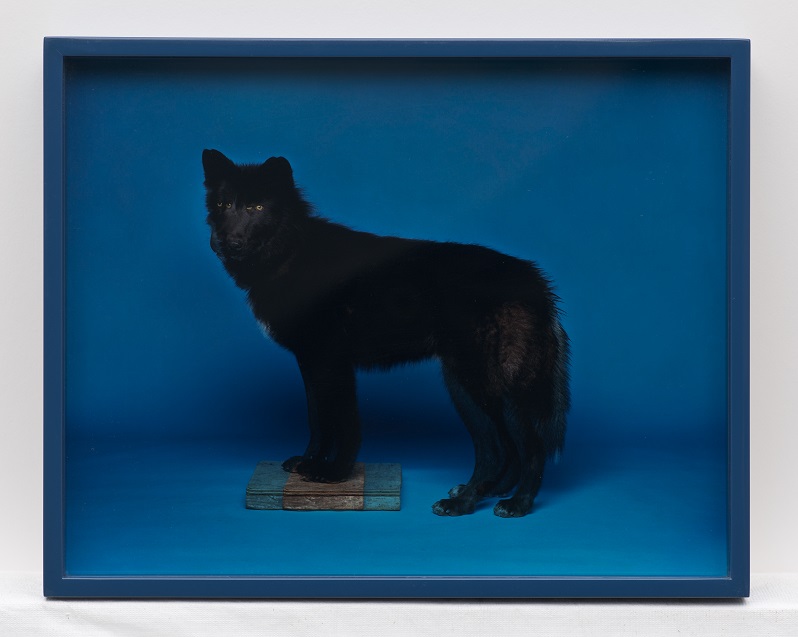
Elad Lassry
Israili, 1977-
Wolf (Blue), 2008
c-print, ed. 3/5
10 3/4 x 13 3/4 in.
SBMA, Museum purchase with funds provided by Tim Walsh
2009.31

Undated photo, Hedi Slimane Fashion Diary
"I have always been intrigued, perhaps even panicked by the option of multiplicity." - Elad Lassry
COMMENTS
A black wolf with yellow eyes framed in a blue box stares out from the flat image. Elad Lassry's photograph "Wolf (Blue)" shows the full body of a wolf, seen from the side. Its front legs are mounted on a mark, a wooden box used to position the subject. The wolf is an actor, and the photograph is staged. (Lassry often works with found objects and images, sometimes re-photographing photographs, but here he composed and took the photograph of this trained wolf himself, aided by two wolf trainers. It is a primary image.) A slight blur in the wolf's face reveals on close inspection a second pair of eyes, set slightly apart, side-by-side, superimposed on the wolf's face. And not only the eyes, but also its legs, front and hind, are doubled. The hind legs noticeably, the front legs less distinctly. One wolf or two? The same wolf twice? One wolf in two different places and instants of time? Lassry's "Wolf (Blue)" superimposes two images of a wolf, one or more wolves, onto an apparently single body. Not a singular body, as few are even when they are, but a single body marked by too many eyes, too many legs, too many bodies. Not the entire body, but the eyes and legs and perhaps other stretches of body indiscernible. The singularity of Lassry's image resides in the photograph, not the animal's body. But the work's singularity is disrupted by the doubling effect that generates a "feeling" of movement, of still life in motion. Of wolves wolfing. The feeling of a perception, because the perception itself remains obscure, blurred as it were in the intensity of feeling that Lassry's wolf or wolves provoke. (Feelings, affect, where the perception is elusive.) It is not clear from the image whether there are separate wolves fused togethere, or two separate images of the same wolf merged together at a slight distance. Two wolves or two images? Before this image one feels the separation of wolves from a wolf, one senses the multiplicity, a feeling separating the perception from the image, one image from another.
Lassry's wolf appears to be standing still, even posing. Nothing appears to move, yet the feeling of movement persists everywhere in this image. Where does this sense of motion come from? From the wolf? From the wolf splitting into wolves? Or from the attentive looking of the wolf's proliferating yellow eyes? The trace of movement in Lassry's wolf, if it is movement at all, is minimal, a nearly imperceptible trace of blur, ex-centric to the image. "Wolf (Blue)" captures the action of a still body. It reveals looking as a visible action. One sees in this image, the act of another looking, the movement of another's look.
The question returns, over and over again: one, or several (blue) wolves? One or more bodies, one or more instants of time pressed onto a single surface, and then rendered in deep blue? Does Lassry's blue box give the wolf stereoscopic depth? Is this the source of his movement, the relief, a black wolf out of the blue? Lassry's wolf looks outward from a box that produces a "tromp-l'oeil" frame rendered in space. At work in this wolf's look, its doubled vision outward is the image of depth rendered flat. Lassry's use of shading in the lower background produces in this blue box-frame, a room, a "camera obscura" that echoes the wolf's black body.
Lassry's wolf is taken from two sets of negatives, which were scanned then merged ("sandwiched," he says), a practice, Lassry notes, common in Bauhaus photography...
- Akira Mizuta Lippit, One, or Several (Blue) Molves?
http://www.davidkordanskygallery.com/pdf/press/EL_12_Rat_Hole_Lippit_essay.pdf
